Memory modules with customizable RGB lighting appeared on the market not so long ago, and at first you had to choose: either backlighting or extreme performance. Now this is not too hard to believe, since in the top segment there is practically no choice left – since there are no modules without backlight left in it. Far from all users are satisfied with this: some fundamentally dislike the backlight itself in general, and someone is rightly dissatisfied with the fact that the LEDs have to be powered from the same lines as the memory chips, that is, theoretically, they can interfere with the full potential of the memory. However, the processor innovations of the last couple of years have called into question just the meaning of the existence of extreme modules. Memory controllers, first AMD Ryzen, and then Intel Core, got a couple of modes of operation, which theoretically allows you to overclock memory to higher frequencies, but in practice, delays can increase, so that overall performance will even decrease compared to more conservative modes. This problem is especially pronounced in Intel Rocket Lake, where the Gear1/Gear2 mode switching threshold for most processors is around 3600-3800 MHz.
But such frequencies do not belong to extreme ones for a long time, they are achievable by many DRAM chips, and not just by some selective series, and the backlight does not interfere with this in any way. She herself is gradually, if not gaining popularity, then becoming something familiar – largely due to the efforts of manufacturers of other components, who are also actively engaged in this area. And if the system board and video card are lit, and the case is selected based on this, with all sorts of windows and its own backlight, then it’s somehow strange to leave the “dark” memory. Moreover, the setup has become easier: you no longer need to develop your own software, but compatibility with Asus, ASRock, Gigabyte and MSI backlight control systems is enough.
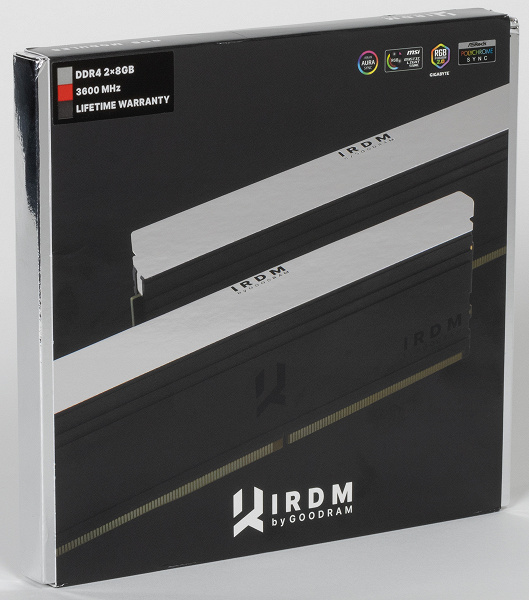
As a result, the corresponding modules have already appeared in almost all manufacturers. Including – and quite conservative, such as the Polish company Wilk Elektronik SA, familiar to many. The main emphasis in its product range so far remains on “traditional” modules with multi-colored heatsinks, but in the fall of the outgoing year, the GoodRAM IRDM RGB DDR4 line also appeared. However, the “line” is still too loudly said: only one set of two DDR4-3600 modules of 8 GB each is available. In other families, there are 8 and 16, and in pairs, and singly, and clock frequencies already reach 4000 MHz. And with backlight – so far only one option. But the option is not without interest, so we decided to get to know him better.
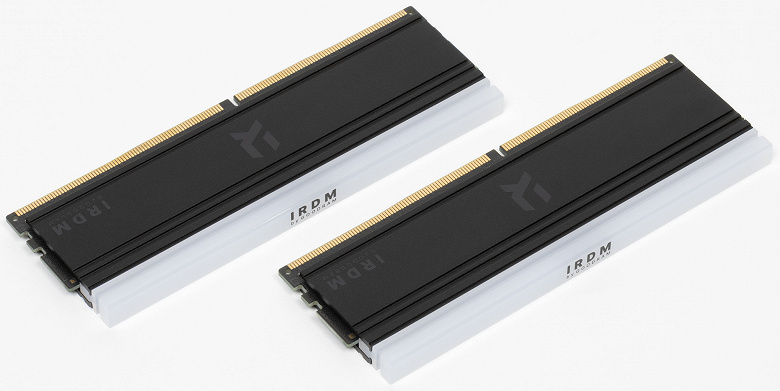
The company remained true to the traditions and did not come up with anything pretentious: the design of the modules themselves is strict and familiar from many other similar products. Their height is 44.8 mm, which is also traditional and taken into account by most cooler manufacturers, so they won’t interfere with each other. The luminous part is a strip of matte plastic on top, in which eight LEDs are hidden. Currently, there are already 10, and even 16 of those, which, in our opinion, is unnecessary. There is no visually noticeable difference, but each LED is far from being powered by the holy spirit, so the fewer there are, the lower the power consumption and the “heating” of the module (which is why many orthodox people still prefer modules with zero LEDs). Black radiators with company logo. The assembly of the module is very high quality: it’s almost impossible to determine by eye that one of the plates performs a purely decorative function, since the memory chips are located only on one side. In general, well-tailored, firmly stuck together – and glowing. There is no proprietary software for management, and it is not necessary – it is more convenient to use the regular one for the motherboard.

The content is fully consistent with the form. Micron chips were announced – they are. It is worth paying attention only to the presence of thermal sensors – often they are not even in more expensive modules. The modules were certified as DDR4-2666, which is also not bad: at least in this mode they are able to work even on boards without an XMP profile and/or those that do not support memory overclocking. There is only one XMP profile here: at a frequency of 3600 MHz with delays according to the 18-22-22 scheme. What was also promised at the announcement and spelled out in the specifications – everything is like a pharmacy.
But we, of course, were interested in what can be obtained from the “not promised.” To test this, we used a test bench with an Intel Core i9-11900K processor and an Asus ROG Maximus XIII Hero motherboard based on the Intel Z590 chipset. Our processor in Gear1 “withstands” 3733 MHz (like most of its colleagues; a few instances rise higher ), which was tested on different sets with frequencies of 3600+. Unfortunately, the GoodRAM IRDM RGB DDR4 set could not work in this mode. There are no problems with working in the “normal” mode, but we managed to increase the frequency above 3600 MHz only by switching to the Gear2 mode.
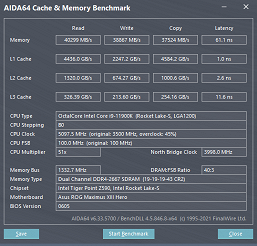


At the same time, there were no more problems with a frequency of 4000 MHz – which, in general, is also a little, seen and better. And the delays in this mode turn out to be higher than when choosing the XMP profile. On which, in our opinion, it is worth stopping in this case.
To test memory performance on an AMD platform, we used the AMD Ryzen 5 5600G and the ASRock B550 Extreme4 board based on the AMD B550 chipset. Why APU? Because the monolithic design of those often allows you to get a higher memory frequency without switching the controller mode – chiplet models are worse in this regard.

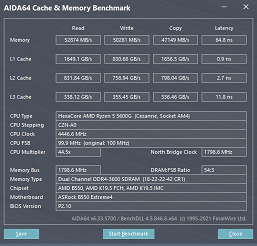
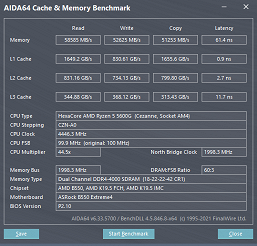
However, the miracle did not happen: they took 4000 MHz, and exactly as it should , but nothing more. It is worth paying attention here to the fact that by default the controller operates at half the frequency. Therefore, you still have to configure something for proper operation, but the easiest way is to enable the XMP profile. But if you wish, you can slightly overclock the modules on this platform, especially if they are paired with APU processors – so (when using integrated graphics) high memory frequencies are most useful.

The general verdict will be short: the manufacturer fulfilled all its promises, and counting on something more is fraught with unfulfilled expectations. On the other hand, in modern conditions, nothing more, in fact, is needed. Let’s say we get the usual (already) 3733 MHz in Gear1, so what? This is only 3% faster than the frequency from the XMP profile – with a proportional (and not exactly the same) contribution to performance. At the same time, GoodRAM modules can be considered compact by today’s standards, they are inexpensive, the backlight works, so they will find their buyer. The only thing we didn’t like was the manufacturer’s rigid focus on 8 GB modules. We understand that a pair of such sticks is now the most popular option even for the most modern computers. Including powerful games: according to Steam statistics, for example, 16 GB of memory is installed in almost half of the systems. And larger volumes are one and a half times less common than, for example, 8 GB (this has long been not enough for games, and not only for games, but not everyone has the opportunity to upgrade an old computer). And yet, it’s already the third decade of the 21st century – it’s time to move on and offer customers 32 GB at least as an option. Moreover, there are such kits in the manufacturer’s assortment – but so far only without backlighting.
In conclusion, we suggest watching our video review of the GoodRAM IRDM RGB DDR4-3600 memory module kit:
Our video review of the GoodRAM IRDM RGB DDR4-3600 memory module kit can also be viewed at iXBT.video




